Its Hard for comedic stars to stay relevant through the decades, they may luck out with physical gimmicks (The Pink Panther), or perhaps the weird persona sells it (any “Ernest” films)
If it works, audiences will buy tickets to view the latest bumbling of a somewhat functioning jester. We revel in the behavioral nature of the uninhibited rebel, breaking norms on screen in what we the audiences wish to do off screen.. Silent film actors like Fatty Arbuckle; Charlie Chaplin, even present day Bill Murray, represented the unleashed ids of moviegoers ready to identify with a man/child rule breaker. How long does that last before the comedian wears out his welcome and begins to resemble your grandpa wearing those disco pants you thought he got rid of. Jerry Lewis once disapproved of the Farrelly Brothers” Dumb and Dumber, in particular Jim Carrey’s toilet humor approach of Lloyd, indeed the short cropped hairstyle and awkwardness was in some ways homage to the Lewis’s own geeky character Julius Kelp in the Nutty professor.
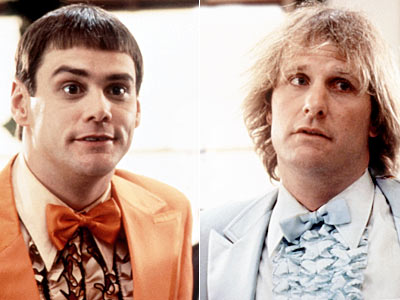
Reaching for the lowest common denominator, "Bumblee Tuna" nearly typecast Carey as "the guy who does stupid stuff.."
Lewis summed up his disapproval of the tone of the movie and perhaps Carrey as well. Had he looked a bit thoroughly, he might have picked up Carrey’s choices of bobbing back and forth between low art and better art, from Ace Ventura crudeness to concepts like the very Tex Avery styled The Mask.
Lewis did the reverse or rather stayed the same, continuously playing the same buffoon from previous roles. He was once half the comedy duo of Dean Martin in the late forties before striking out on his own.. but things change, political administrations come and go, economic times go up and down , the caricature of a man -child act can only go so far. This is probably the reason why Lewis’s career stalled in the 60’s and went dead in the 70’s, like the proverbial peter Pan, Lewis never wanted to grow up, Movies like Hardly working only painfully revealed that the times have finally and decisively caught up with him.
And this is where Jim Carrey comes in, veteran of the TV show in Living Color, he branched into the film world, catering first to the college frat crowd with low brow humor but also engaging in more ambitious comedies like the Truman show. Carrey avoids the mistake Lewis made in his career, realizing just in time that burlesque antics eventually wears thin with each generation. So a change was needed if you wanted to stick around a little longer.
Carey had some miss-steps along the way. Wanting to be taken seriously, he overplayed his hand in the Majestic, A Capra influenced knock off that gives new meaning to the word maudlin. The Number 23, a semi-horror mystery drama became a mystery on why it was made. Finally taking a page from the Michel Gondry’s film Sunshine of the spotless mind, he may now be finding his niche balancing his unique style with off the wall quirkiness. It’s not the character that’s funny but the situation around him.
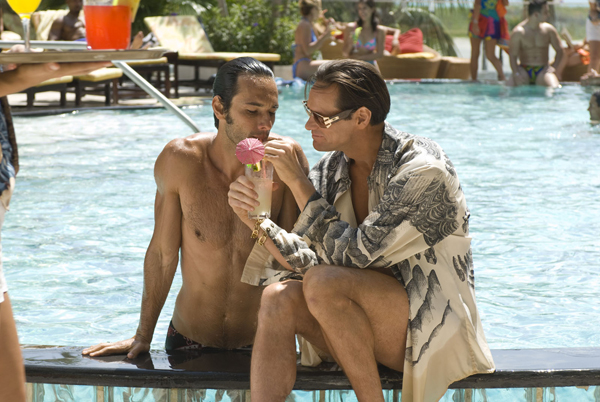
Carey creates a caricature of a gay character that anyone who lived through the 80s decade of gluttony can relate to: The pursuit to get Rich fast!
I love you Phillip Morris is the most daring subject yet for Carrey. Based on a true story of a gay con man that gifts his way through life until he finds true love connections with Ewan McGregor, played wonderfully in a gentle doe like performance. With his puppy dog eyes and lilting voice, he makes him a very enticing and literal jailbait that anyone straight or gay would probably fall for. The movie’s protagonist is reminiscence of Spielberg’s film “Catch Me if You Can”, but whereas DiCaprio character was deluding himself of being something he was not, due to lack of family cohesiveness, Carrey’s Steven Russell revel in his con to keep his. If anything the acts of deception by Russell validates the attitudes of economic excess of Reagan-omic indulgence of the 80′s.
There are moments of sweetness that solidify the relationship as in one intermittent scene of Carrey and McGregor slow dancing nonchalantly as Johnnie Mathis‘s Chances are played on, amidst the violent accompaniment of a police shutdown in the next prison cell. The passion and the devotion Russell has in their relationship wasn’t any different than Hawkeye’s declaration of love to Cora in the Last of the Mohicans. Add consistent prison escapes and con jobs gives weight to Russell’s motivations, yes he’s a thief but he’s caring one.
Look we can wonder if Carrey is or isn’t going for Oscar gold with these choices, but I won’t slam him if he tried. After all, everybody wants to stay relevant.
I Love You Philip Morris a beer rates a shot of bourbon.
Cheers,
Greg
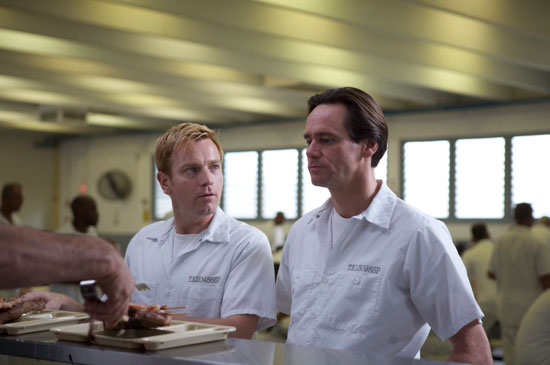
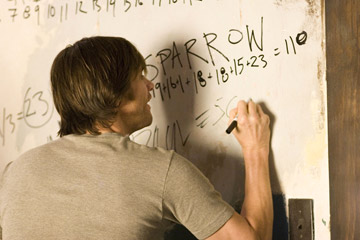

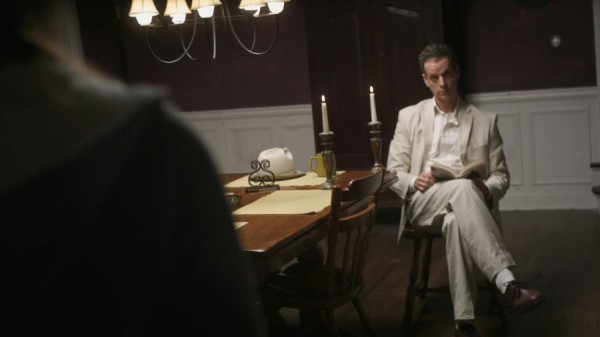

 king place somewhere in the South, The Last Exorcism is about Cotton Marcus, a minister who decides to hire a camera crew to expose the Church’s fraud by performing a staged exorcism with a devout family. What he and the crew don’t realize is that they may actually be dealing with a real possession. It starts off like a Dateline special on minister Cotton Marcus, who sells himself more as a comedian than a minister as he slips a recipe for banana bread into his sermon without the parish realizing it, showing the church’s blinding hold over its people and validating his own hucksterism about religion. The set up makes an interesting news special, but the film wants a “found footage” sense to it, and yet after the introduction on Marcus, there’s rarely a shot that actually feels like someone just filmed it.
king place somewhere in the South, The Last Exorcism is about Cotton Marcus, a minister who decides to hire a camera crew to expose the Church’s fraud by performing a staged exorcism with a devout family. What he and the crew don’t realize is that they may actually be dealing with a real possession. It starts off like a Dateline special on minister Cotton Marcus, who sells himself more as a comedian than a minister as he slips a recipe for banana bread into his sermon without the parish realizing it, showing the church’s blinding hold over its people and validating his own hucksterism about religion. The set up makes an interesting news special, but the film wants a “found footage” sense to it, and yet after the introduction on Marcus, there’s rarely a shot that actually feels like someone just filmed it. he plot is just as problematic as Stamm tries to blindside the issues with a few curve balls and succeeds only in losing the focus of the narrative, but audience’s patience as well . He keeps you guessing a little bit as he plays with the idea of whether or not the situation is actually real, but in the last act, he crashes the two possibilities together into a train-wreck of an ending. Not two minutes after the film decides to go one way, it completely flips around and finishes with a reveal that only shocks by how absurd it is.
he plot is just as problematic as Stamm tries to blindside the issues with a few curve balls and succeeds only in losing the focus of the narrative, but audience’s patience as well . He keeps you guessing a little bit as he plays with the idea of whether or not the situation is actually real, but in the last act, he crashes the two possibilities together into a train-wreck of an ending. Not two minutes after the film decides to go one way, it completely flips around and finishes with a reveal that only shocks by how absurd it is.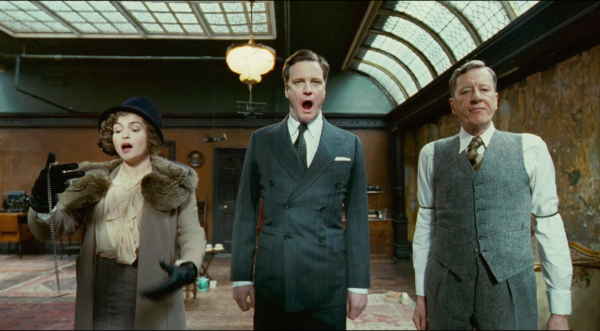
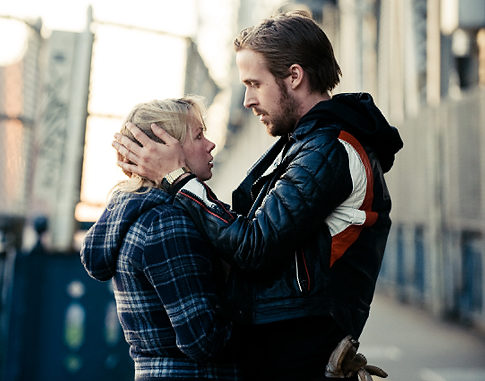
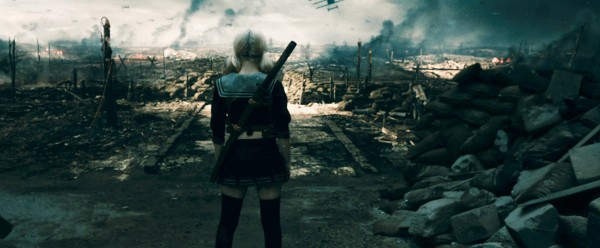

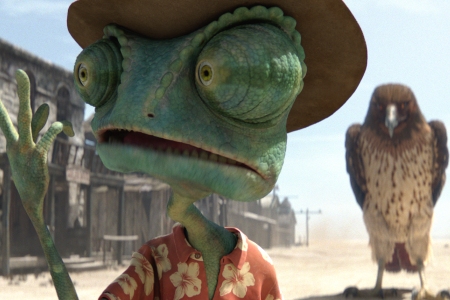
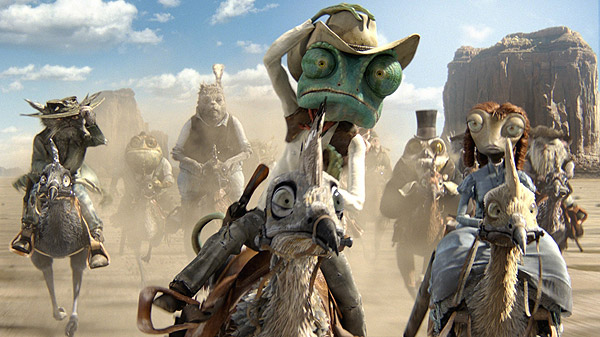
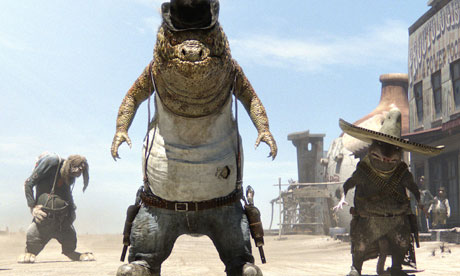 The biggest highlight of the film lies within the gorgeous animation. Standing toe-to-toe with Pixar, the vast color palette and fine details give life to each character as they bask in the desert lighting. Close-ups revel in the most minute features from the scales on Rango’s face to the dry mud in a prospector’s fur. The character designs are also exceptionally unique, playing on the tropes of the Old West and blending them with the most unusual critters you’ll find chilling at a saloon, from an outlaw gila monster and his reptilian posse silencing everyone with their entrance to the town-drunk turkey getting thrown out of the bar. There are even a few characters that may appear gruesome or frightening, such as the menacing Rattlesnake Jake with his demon-red eyes and malicious slithering.
The biggest highlight of the film lies within the gorgeous animation. Standing toe-to-toe with Pixar, the vast color palette and fine details give life to each character as they bask in the desert lighting. Close-ups revel in the most minute features from the scales on Rango’s face to the dry mud in a prospector’s fur. The character designs are also exceptionally unique, playing on the tropes of the Old West and blending them with the most unusual critters you’ll find chilling at a saloon, from an outlaw gila monster and his reptilian posse silencing everyone with their entrance to the town-drunk turkey getting thrown out of the bar. There are even a few characters that may appear gruesome or frightening, such as the menacing Rattlesnake Jake with his demon-red eyes and malicious slithering.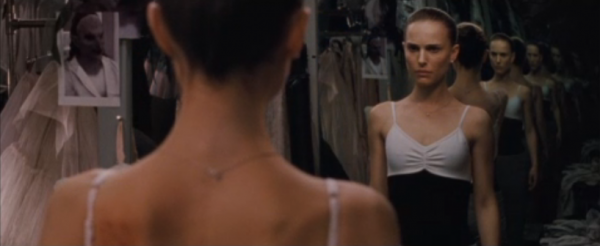

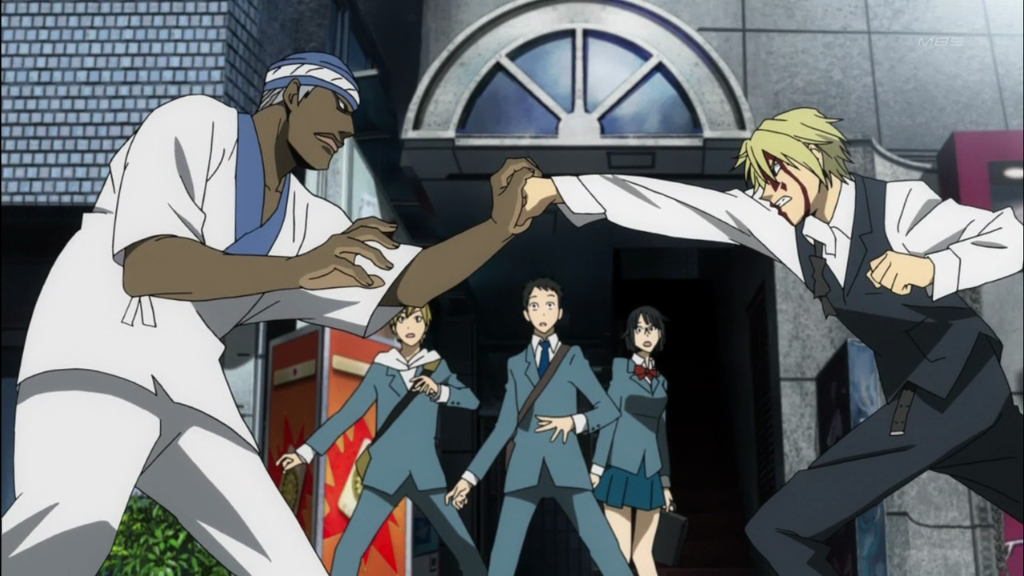

 On the upside, Durarara juggles the drama and humor very well once it gets the ball rolling. The different plotlines stem from reality-based problems such as gangs and teenage love while splicing in supernatural forces from Japanese and Celtic mythology, and like any youth-based story, there are plenty of laughs and light-hearted moments. These are nice touches that never seem overbearing to the series as the story, deep down, is about the characters and their progression through a less-than-ordinary life. As for the animation, it’s slick and vibrant in its use of colors. It may not be like Akira or other anime where every crack or shadow is detailed to convey a sense of realism, but the artwork is stunning to look at most of the time and captures the feel of the city and its inhabitants.
On the upside, Durarara juggles the drama and humor very well once it gets the ball rolling. The different plotlines stem from reality-based problems such as gangs and teenage love while splicing in supernatural forces from Japanese and Celtic mythology, and like any youth-based story, there are plenty of laughs and light-hearted moments. These are nice touches that never seem overbearing to the series as the story, deep down, is about the characters and their progression through a less-than-ordinary life. As for the animation, it’s slick and vibrant in its use of colors. It may not be like Akira or other anime where every crack or shadow is detailed to convey a sense of realism, but the artwork is stunning to look at most of the time and captures the feel of the city and its inhabitants.











